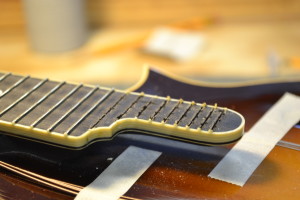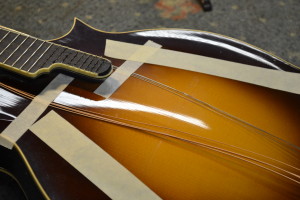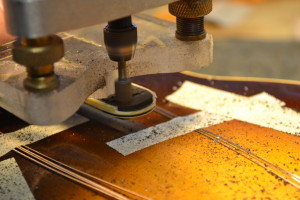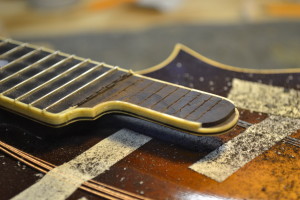Scooping the mandolin’s tongue extension, sometimes called the “Florida” allows the pick held in the right hand to have access to what most people call the “sweet spot” without hitting the frets in that area. The clicking you hear and the aggravation you may experience while using the pick in this area can be completely alleviated by this procedure.
Clicking on the pictures brings up a full size image. They may take a while to load depending on your connection speed.
I never recommend that a vintage mandolin be altered in this way as it is impossible to undo without a great deal of work, but I have seen it even on a signed Lloyd Loar F-5.  I begin by
I begin by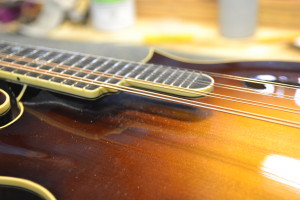 insuring that the binding is tightly fastened in this area. A piece of binding that is not secure will cause problems when the router bit cuts into it. The binding on this mandolin was in need of securing near the tip of the extension on the treble side, so that was taken care of first. The strings were then loosened and carefully taped to the face of the mandolin as they were fresh. The frets were then carefully removed from the extension and the “F” holes were taped off. This procedure makes quite a mess as you will see.
insuring that the binding is tightly fastened in this area. A piece of binding that is not secure will cause problems when the router bit cuts into it. The binding on this mandolin was in need of securing near the tip of the extension on the treble side, so that was taken care of first. The strings were then loosened and carefully taped to the face of the mandolin as they were fresh. The frets were then carefully removed from the extension and the “F” holes were taped off. This procedure makes quite a mess as you will see.
The router base that I am using was made in my shop by laminating pieces of plexiglass together and attaching it to a fixture sold by StewMac. Because I am a luthier who makes his living working on instruments I usually purchase specialty tools if they are available instead of building them if at all possible. This allows more efficient use of my time building and repairing instead of spending hours or even days building gigs and tools.
I carefully route only a small amount of material at a time. This fingerboard is made of ebony and even though this mandolin isn’t very old, this material can be brittle and chip quite easily. The older the ebony the more prone this material is to chipping so caution should be taken when pulling the frets and routing. Heating the frets is highly recommended as you are pulling them. Heating the binding is not … their is a line not to be crossed if you are working with celluloid binding (newer binding doesn’t have the same properties and behaves differently) as it is self oxygenating and will burn quite nicely if you get it too hot with a soldering pencil or iron while heating the frets in order to remove them, or while routing the scoop. If you don’t have the tools and experience necessary to perform this task it isn’t recommended that you undertake it.
 The routing makes a huge mess. A vacuum isn’t
The routing makes a huge mess. A vacuum isn’t 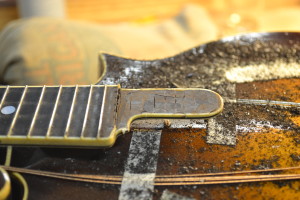 the easiest thing to rig up to the router in this case without making it bulky and much more difficult to use. I did have a smaller rig attached to it years ago but it wasn’t very effective so I now opt to clean up the mess after the job is completed.
the easiest thing to rig up to the router in this case without making it bulky and much more difficult to use. I did have a smaller rig attached to it years ago but it wasn’t very effective so I now opt to clean up the mess after the job is completed.
I keep routing a little at a time adjusting the router bit for a deeper cut with each pass until one of two things happen first: I have .060″ of binding left or I clear the bottom of the fret slots. Sometime the fret slots are quite deep and I end up filling them. I have also installed an inlay in this area which looks quite nice to me. If you fill them you will be able to see them even if you use ebony dust and CA or epoxy. Some people opt to fill them with something white so that from a distance it looks like the frets are still there. I like all three methods. For this mandolin I was able to get just past the bottom of the fret slots, so no problem.

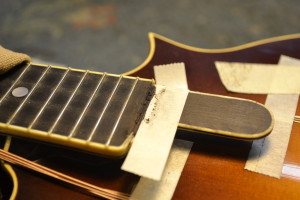 Rounding off the edge of the route line and smoothing the machine marks from the router bit is easily done by hand. I use a round file (not shown) to feather the two areas together and other methods like razor blades and sandpaper are used as well. It is very important to me that my work look as perfect as possible. This mandolin is thousands of dollars, but I would treat a $300.00 the same. The same care and time goes into scooping either mandolin. The rest of the photos are self-explanatory and I hope will gain you an appreciation for the amount of care, time and experience that goes into this job.
Rounding off the edge of the route line and smoothing the machine marks from the router bit is easily done by hand. I use a round file (not shown) to feather the two areas together and other methods like razor blades and sandpaper are used as well. It is very important to me that my work look as perfect as possible. This mandolin is thousands of dollars, but I would treat a $300.00 the same. The same care and time goes into scooping either mandolin. The rest of the photos are self-explanatory and I hope will gain you an appreciation for the amount of care, time and experience that goes into this job.
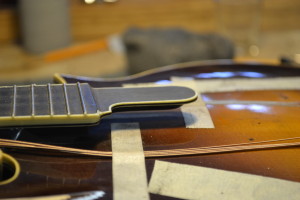
Cleaning, sanding and smoothing. Making the job look factory is important.
The job looks great and their is plenty of room in the “Sweet Spot” for the pick now.
Thank you for spending this time with me. Here at Acoustic Box LLC I love sharing my knowledge with you.
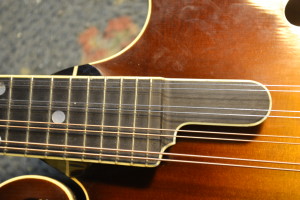 |
 |
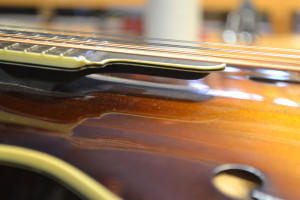 |
Please let us know what you thing my e-mailing me.
Sincerely,
Richie Dotson


